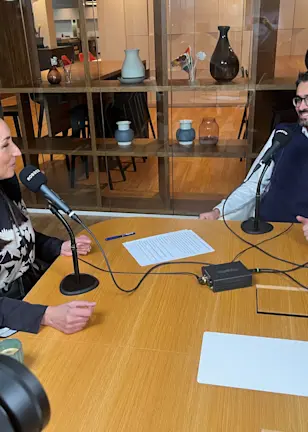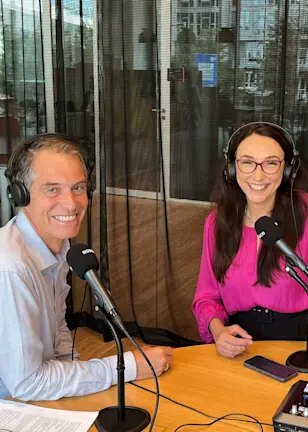Important information
The Robeco Capital Growth Funds have not been registered under the United States Investment Company Act of 1940, as amended, nor or the United States Securities Act of 1933, as amended. None of the shares may be offered or sold, directly or indirectly in the United States or to any U.S. Person (within the meaning of Regulation S promulgated under the Securities Act of 1933, as amended (the “Securities Act”)). Furthermore, Robeco Institutional Asset Management B.V. (Robeco) does not provide investment advisory services, or hold itself out as providing investment advisory services, in the United States or to any U.S. Person (within the meaning of Regulation S promulgated under the Securities Act).
This website is intended for use only by non-U.S. Persons outside of the United States (within the meaning of Regulation S promulgated under the Securities Act who are professional investors, or professional fiduciaries representing such non-U.S. Person investors. By clicking “I Agree” on our website disclaimer and accessing the information on this website, including any subdomain thereof, you are certifying and agreeing to the following: (i) you have read, understood and agree to this disclaimer, (ii) you have informed yourself of any applicable legal restrictions and represent that by accessing the information contained on this website, you are not in violation of, and will not be causing Robeco or any of its affiliated entities or issuers to violate, any applicable laws and, as a result, you are legally authorized to access such information on behalf of yourself and any underlying investment advisory client, (iii) you understand and acknowledge that certain information presented herein relates to securities that have not been registered under the Securities Act, and may be offered or sold only outside the United States and only to, or for the account or benefit of, non-U.S. Persons (within the meaning of Regulation S under the Securities Act), (iv) you are, or are a discretionary investment adviser representing, a non-U.S. Person (within the meaning of Regulation S under the Securities Act) located outside of the United States and (v) you are, or are a discretionary investment adviser representing, a professional non-retail investor. Access to this website has been limited so that it shall not constitute directed selling efforts (as defined in Regulation S under the Securities Act) in the United States and so that it shall not be deemed to constitute Robeco holding itself out generally to the public in the U.S. as an investment adviser. Nothing contained herein constitutes an offer to sell securities or solicitation of an offer to purchase any securities in any jurisdiction. We reserve the right to deny access to any visitor, including, but not limited to, those visitors with IP addresses residing in the United States.
This website has been carefully prepared by Robeco. The information contained in this publication is based upon sources of information believed to be reliable. Robeco is not answerable for the accuracy or completeness of the facts, opinions, expectations and results referred to therein. Whilst every care has been taken in the preparation of this website, we do not accept any responsibility for damage of any kind resulting from incorrect or incomplete information. This website is subject to change without notice. The value of the investments may fluctuate. Past performance is no guarantee of future results. If the currency in which the past performance is displayed differs from the currency of the country in which you reside, then you should be aware that due to exchange rate fluctuations the performance shown may increase or decrease if converted into your local currency. For investment professional use only. Not for use by the general public.
Sustainable Investing
What is Sustainable Finance Disclosure Regulation?
The EU Sustainable Finance Disclosure Regulation (SFDR) standardizes metrics for assessing environmental, social, and governance (ESG) impacts of investments, ensuring funds' sustainability profiles are comparable. It mandates detailed disclosures, including identifying harmful impacts caused by investee companies.
The regulation forms part of the EU’s wider Sustainable Finance Framework which is backed by a broad set of new and enhanced regulations that apply across the 27-nation bloc. The SFDR goes hand in hand with the EU’s Sustainable Finance Action Plan which aims to promote sustainable investment across the EU, and a new EU Taxonomy to create a level playing field across the whole EU.
All the new measures are a response to the landmark signing of the Paris Agreement in December 2015, and the United Nations 2030 Agenda for Sustainable Development adopted earlier in 2015, which created the Sustainable Development Goals. The SFDR and other regulations are also aligned with the European Green Deal, which aims to see the EU carbon neutral by 2050.
SFDR regulation
SFDR is an evolving set of EU rules aiming to create a level playing field for how sustainable investment strategies are classified by asset managers. It helps to clarify the definition of a ‘sustainable fund’ and combat the growing threat of greenwashing.
Level I and Level II
Level I of the SFDR was introduced in March 2021. Its most visible and impactful element was the classification of funds and mandates in three categories, as laid down in Articles 6, 8 and 9 of the SFDR.
Article 6 funds: those that do not promote their environmental social or governance (ESG) characteristics.
Article 8 funds: where a financial product promotes, among other characteristics, environmental or social characteristics, or a combination of those characteristics, provided that the companies in which the investments are made follow good governance practices.
Article 9 funds: where a financial product has sustainable investment as its objective and an index has been designated as a reference benchmark.
Most Robeco funds are classified as Article 8, with many of the funds in the Towards Impact Investing range classified as Article 9, and only a handful classified as Article 6.
Level II of the SFDR was introduced in January 2023. The three articles remain in place, but a notable update is in stricter interpretations of what constitutes a wholly sustainable investment. Robeco subsequently updated its operational definitions for its range of funds that wish to be classified as Article 9.
This brought a change in that Article 9 funds must do one of three things. They can only include companies that have positive scores under the SDG Framework which measures the contributions that companies make to the Sustainable Development Goals. Alternatively, Article 9 funds can include funds that set a specific carbon reduction objective and use a Paris-Aligned Benchmark or a Climate Transition Benchmark. Finally, investments in green, social, and sustainability bonds are eligible.
Identifying adverse impacts
Identifying the impacts that fund managers and the companies in which they invest have on wider society was introduced under Level I in June 2021 and tightened under Level II from January 2023. These rules require an asset manager to describe its due diligence policy on how it will take the principal adverse impacts which investee companies have on sustainability factors into account when making investment decisions.
This are monitored using a system of 64 Principle Adverse Impact Indicators (PAIs), of which 18 are mandatory to report, and 46 are voluntary. The compulsory factors range from carbon emissions, fossil fuel exposure and waste levels (E) to gender diversity and due diligence over human rights (S) and a company’s record on exposure to corruption, bribery or other scandals (G).
Having already introduced PAI reporting at the company level in 2021, Robeco began reporting performance at the fund level in January 2023. Article 9 funds will address all the mandatory PAIs; Article 8 funds will report on actions taken to mitigate adverse impacts on an annual basis through regular fund reporting.
















